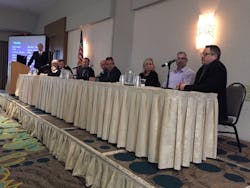A panel of shop, insurance, scan tool, and OE representatives discuss pre- and post-repair scanning challenges at the January Collision Industry Conference meeting in Palm Springs.
PALM SPRINGS, Jan. 12, 2017—Pre- and post-repair scanning, a topic that dominated the collision repair industry in 2016, continues to be top-of-mind for repairers and was the focus of a lengthy panel discussion during the Collision Industry Conference ’s (CIC) first meeting of 2017.
“I’ve been involved in quite a lot of CIC things over the years and I haven’t seen quite the level of interest before that I have with this one,” said Mitchell International’s Jack Rozint, chairman of CIC’s Emerging Technologies Committee and moderator of the panel, before kicking off the discussion.
To differentiate the conversation from several previous panel discussions on scanning that have taken place at various industry events, Rozint noted that the panel would not cover which vehicles to scan, or compensation related to scanning. Instead, the talk surrounded challenges and issues related to scanning late-model vehicles with complex electronics.
Panelists included Darrell Amberson of LaMettry’s Collision in the Twin Cities, Matt McDonnell of Big Sky Collision Center in Montana, Jake Rodenroth of Collision Diagnostic Services, Chuck Olsen of AirPro Diagnostics, John Eck from General Motors (GM), Mark Allen from Audi of America, Chris Evans from State Farm, and Sandee Lindorfer from Allstate.
Rozint started the discussion asking Rodenroth for an example of when a pre-scan brought to light information that was otherwise unknown, leading to a better repair plan. Rodenroth shared one instance in which a vehicle showed one fault code: lost communication with the airbag control module in the instrument cluster. The shop found that someone had put a resistor in the wiring harness to cheat the airbag light from coming on.
“I immediately said I’m not sure what your facts of loss here are as far as your point of impact and things like that, but you definitely need to get the consumer and the insurer involved so they can do their due diligence on their side,” Rodenroth said.
That alarming example set the table for the rest of the conversation.
Rozint followed by asking the OEs what can be done to better integrate repair information, to ensure it is available and used. Eck said the use of repair procedures, based on GM’s research, is “concerningly low,” and the OEs need to work with information providers to make accessibility and use easier, faster and more intuitive.
“I understand the cost and the process and the payment issues, but we’re talking about a safe repair,” Eck said. “Where does collision stop and electronic diagnostics start? It’s not after the sheet metal anymore … it’s all one system working together as designed and scanning is absolutely critical. Following repair procedures for a safe repair is absolutely critical. And it’s not being done.”
Allen agreed that working with information providers and insurers is important for improving how customers are educated and serviced. But on scanning, he noted that there’s a danger in clearing history following a pre-scan, which is a big reason Audi has not come out with a position statement on scans.
“You’re not just affecting the collision world. You’re affecting any of the campaigns that we do to update those computer systems for the functioning of that entire vehicle system,” he said.
Amberson, who said LaMettry’s scans about 1,000 vehicles each month, said the industry often runs into issues in which scanners are viewed as a “magic box” that clears codes and life goes on. How those codes are addressed and documented is a crucial aspect of the scanning conversation, he said. Documentation was stressed by all panelists later.
Rozint also asked what happens when a problem shows up that is unrelated to a collision.
McDonnell, who said his shop performs scans on every vehicle it repairs, said the information is presented to the insurance company and a “team plan” is created before going back to the customer. When items are not covered, they are explained to the customer, along with associated costs.
Lindorfer said it’s a case-by-case issue and Allstate will work with shops to determine the right thing to do for each customer.
“One thing that we all have in common is that we want to put the customer back in a safely repaired vehicle,” she said. “But the challenge is the customer doesn’t understand.”
Lindorfer reiterated the need to work with all stakeholders to educate customers and all panelists saw that as necessary moving forward.
“That’s the kind of collaboration and cooperation that will make this work moving forward,” Evans added. “Where we have the transparency and the proper information necessary to communicate to that customer.”
